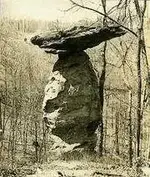Oroblanco
Gold Member
- Joined
- Jan 21, 2005
- Messages
- 7,841
- Reaction score
- 9,876
- Golden Thread
- 0
- Location
- DAKOTA TERRITORY
- Detector(s) used
- Tesoro Lobo Supertraq, (95%) Garrett Scorpion (5%)
- #301
Thread Owner
Hi Mike,
Did you read my lengthy post? The two photos at the bottom ARE man-made, they are called Inukshuk; they are found all over the far north as trail markers NEAR villages (usually) and in the southwest as Coyote scarecrows, very like the Jackal scares of the Mid-east. I have to use stock photos, as I have not bothered to take photos of natural formations.
I can't believe that the Spaniards or Mexicans or anyone in the southwest bothered to make whole mountains into "markers" of any kind. Think of the "Old Man of the Mountain" of New Hampshire which lately fell off:

Think someone clambered over the side of the mountain to "make" it? Hardly! It is just a natural formation.
Compare it to Mount Rushmore:

I have a little personal rule when it comes to stone formations - if you have to squint a little to "see it" then it is most likely natural.
So I guess we disagree on many stone formations - of course if I am wrong, then Mike will find the treasures and have the last laugh!
Oroblanco
Did you read my lengthy post? The two photos at the bottom ARE man-made, they are called Inukshuk; they are found all over the far north as trail markers NEAR villages (usually) and in the southwest as Coyote scarecrows, very like the Jackal scares of the Mid-east. I have to use stock photos, as I have not bothered to take photos of natural formations.
I can't believe that the Spaniards or Mexicans or anyone in the southwest bothered to make whole mountains into "markers" of any kind. Think of the "Old Man of the Mountain" of New Hampshire which lately fell off:

Think someone clambered over the side of the mountain to "make" it? Hardly! It is just a natural formation.
Compare it to Mount Rushmore:

I have a little personal rule when it comes to stone formations - if you have to squint a little to "see it" then it is most likely natural.
So I guess we disagree on many stone formations - of course if I am wrong, then Mike will find the treasures and have the last laugh!
Oroblanco








